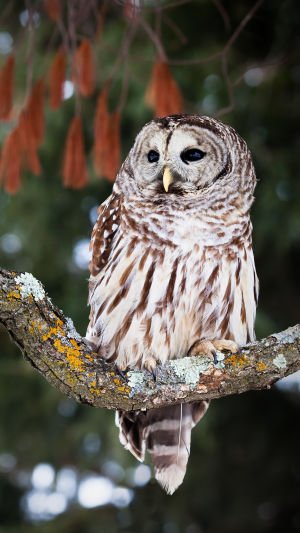The owl is a very mysterious animal. The most curious thing is its special function of "turning its head"!Like a searchlight, it can rotate its neck nearly a full circle.
The owl, whose vision is originally smaller than that of a human, can use its head-turning stunt to see a wider angle. In fact, there is a reason why it can be reversed so drastically!
Because the head and neck bones of an owl have a total of 14 segments, which can expand the space for movement. In addition, its neck movement is close to the center of the cervical spine, so when it is twisted, it will not compress the blood vessels and avoid blood vessel blockage.
Looking left and right, the owl has big round eyes, which is powerful, and there is this trick, the head-turning stunt. It seems to turn 360 degrees in a big circle, but in fact, it turned 270 degrees, but if you turn it over and over again, won't your neck break?
In addition to having more bone segments and increasing the range of motion, scientists also found that when the owl's blood flows to the jaws, it will expand, gather, and accumulate enough blood flow to ensure that the owl will not interrupt the blood flow when turning its head.
In addition, its carotid artery is close to the center of the cervical spine. When the head is turned, it is less likely to compress the blood vessel and cause blood vessel blockage. But how did the owl master this special function of "turning its head"?
Turning the head, the field of view is super wide-angle, and the owl can clearly distinguish the surrounding environment and avoid being attacked by enemies. It relies on the special structure of bones and blood vessels to create the jaw-dropping head-turning stunt of the owl.
Generally speaking, the life span of owls is about 20 to 30 years for large owls; 6 or 7 years for small owls.
Owls are nocturnal birds of prey under the class Aves. The beak is strong and hooked, and the cere at the base of the mouth is covered by hard whiskers.
The claws are large and sharp. The chicks are late mature. Tail glands exposed. No secondary feathers, occasionally retained.
Most owls are nocturnal carnivorous birds, they perch on dense trees during the day, and only go out at night. This is because owls have well-developed night vision and hearing.
According to scientific research, there are about 90,000 to 100,000 auditory cells in the ears of owls, but there are only 18,000 auditory cells in adults.
Moreover, although the owl's ears are located on both sides of the head like other animals, its ear holes are asymmetrical and have different shapes, which is conducive to its collection and positioning of sound.
Of course, the owl's ability to move at night does not rely solely on hearing. Its big piercing eyes are different from other birds. First, the pupils of owls are large, which facilitates the entry of light.
Secondly, the owl's rod cells contain rhodopsin, which can accurately distinguish between light and dark. Therefore, at night, even with only a little light, the owl can see very clearly (just in black and white).





